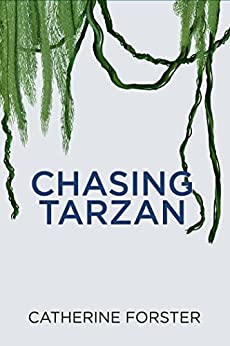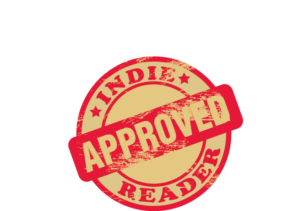Chasing Tarzan received a 4+ star review, making it an IndieReader Approved title.
Following find an interview with author Catherine Forster.
What is the name of the book and when was it published?
Chasing Tarzan; July 26, 2022
What’s the book’s first line?
I was barefoot in the front yard, my toes warmed by a sunbaked sidewalk.
What’s the book about? Give us the “pitch”.
Chasing Tarzan is an unflinching and humorous memoir about the ripple effects of bullying, how it shapes who we become, and impacts our closest relationships. The book also illustrates the limits and the power of imagination when it comes to drowning out pain. I retreated far inward so my tormentors could not reach me, not realizing no one else would be able to either, or that a rich internal world changed nothing. I woke to this truth and sought action, becoming an exchange student. In New Zealand, I took on a new persona: the popular girl, and fooled everyone; except for my Kiwi host “mum,” who saw through my façade and pulled me out from my inner safe-house. Exposed, my sense of self imploded, and I was forced to rethink who I was.
What inspired you to write the book? A particular person? An event?
The rekindling of my own memories of being bullied and my daughter’s struggle with her tormentors inspired Chasing Tarzan. Like many people, I buried the painful memories of my childhood, locking them deep within my head. My own child’s struggle and a safari trip to Africa brought them roaring back. On safari, I imagined Tarzan everywhere: peeking into our tent, riding a bull elephant, running alongside the wildebeest. It was as if he were chasing me, or my memories were. In writing Chasing Tarzan, I upended the paradigm––I was chasing him, hunting for the meaning of those hidden memories.
What’s the main reason someone should really read this book?
I wrote the book so that those struggling with bully or its long-term effects would not feel alone. I want the targeted to know that what they are experiencing, or encountered in the past, is indeed abuse. I was told that bullying was a fact of life, part of growing up, that one would be stronger for it. This is not the case. Individuals who are the target of severe bullying (whether physical or verbal) are more likely to struggle with their relationships, suffer from depression, addiction, and suicide. It is my hope that Chasing Tarzan will help young readers seek positive solutions, and begin the process of fortifying their own voice. For those still suffering from trauma inflicted long ago, I hope the book shines a light on that past, laying bare the truth––the mistreatment was not their fault, and they did not deserve it.
When did you first decide to become an author?
I am and artist, a filmmaker, a writer, a mother, a wife, and a kayaker who loves to bake. I’ve been an artist since the day that first crayon was placed in my hand, writing, on the other hand, was not a venture I planned. It wasn’t a conscious decision, but rather, an unfolding process. Initially, I created a picture journal with captions. As my daughter was also the target of bullies, I elected to write private passages for her. These early writings became a series of short stories; the beginnings of a book.
How much time do you generally spend on your writing?
Unless I’m immersed in a writing period, I don’t write full-time. I have to make space for both my art practice and writing projects. When I have an exhibition deadline, I focus on producing work. When I’m buried in a writing project, nothing can pull me away.
My most productive time varies depending on each discipline. I write early, first thing in the morning before the world intrudes. I begin by reading, filling my head with good sentences and vibrant words. So as not to be overly influenced by one writer’s voice, I read at least three books at a time, studying choices the author is making. Next, I read my own work, starting with the previous chapter. And I’m not a coffee-shop writer. I need total silence. I have a favorite room––not my studio, which is for making and reflecting on art––and writing chair. I write from 6AM until noon, have lunch, go for a walk or kayak. It is in nature that I resolve both writing and art problems.
What’s the best and the hardest part of being an indie?
Obviously, marketing. The platform I have built over time is focused on visual art and experimental film. It is not the best platform for promoting a book, unless it’s art related. Even then, I am not skilled in social media promotion, most artists aren’t––we like being in the studio. So, getting the book into buyers’ hands, or seen amongst the vast number of books published each month, is hugely difficult, and not just for indie publishers. Especially for memoirs, whether published independently or traditionally, if you are not a celebrity, getting the word out is daunting. I am exceedingly proud of Chasing Tarzan’s 4/4 IndieReader review, and hope it will inspire readers to buy the book.
Would you go traditional if a publisher came calling? If so, why?
Good question, and yes, I would. I am fully aware marketing would still be on me, but the cachet of a book that is traditionally published does give one more to work with. It is also helpful when attempting to get the book into libraries and schools.
Is there something in particular that motivates you (fame? fortune?)
As with my art practice, I am motivated by how the work touches the viewer/reader, and creates a dialogue around the themes I am working on. I have been inspired by the reaction to the book, how readers have reached out and shared that reading Chasing Tarzan provided insight into their own childhoods. Some readers were so moved by the book they bought it for their local schools and school counselors. What could be better?
Which writer, living or dead, do you most admire?
Willa Cather.
Which book do you wish you could have written?
Just Kids, by Patti Smith.

